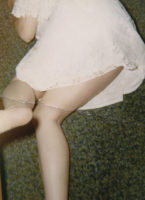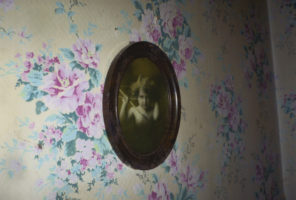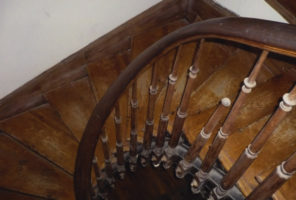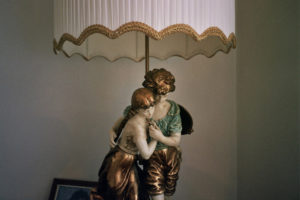Melissa Catanese‘s Dive Dark Dream Slow might be one of the most successful and exciting recontextualizations of vernacular photography in recent years. With both vernacular photography and such efforts having become widely accepted in the world of art photography, I wanted to find out more, both about the book and its maker. The following conversation was conducted via email over the course of a few weeks.
Jörg Colberg: Before talking about Dive Dark Dream Slow in more detail, can you talk a little bit about why/how you became interested in vernacular photography? Why is it interesting?
Melissa Catanese: I never really sought out working with vernacular photography specifically, but a strong interest in using other people’s photographs developed in graduate school in 2004 and 2005. I became focused on working with groups of images and how meaning and narrative can be shaped through editing and sequencing. This led me to consider working with other source material besides my own photographs. I worked on a book with Ed Panar called Yesterday’s Beach, Tomorrow’s Forest from a friend’s personal archive of photographs taken in the 80’s and 90’s. From there we went on to create a fictitious photographer named Lester Pleasant. Lester was mostly three of us, but really anyone could contribute to his archive. It was under his identity where we could edit one another’s photographs, weaving them all together with levity and without ego or self-consciousness, more or less. This conversation opened my eyes to this profound ambiguity that exists in a photograph and the potential meanings that can be made from that ambiguity, especially when moved around within a sequence.
When I began working with vernacular photography it was like going back to ground zero in revealing an essential truth that all photographs are these strange mysterious artifacts that can be so easily removed from their original meaning and intent. It sounds a bit new age, but once I started exploring Peter Cohen’s collection, I felt a draw to the photographs, a weird magnetic pull. These little objects have a strange autonomy and it’s hard to articulate this nearly mystical element of working with them. They were seducing me. As if they had been waiting to be reactivated (or liberated) from the circumstances by which they were first made. But also, I wanted to tap into their inherent strangeness, darkness even, that I believe exists in all images.



JC: How did you meet Peter Cohen, and how did the idea to make Dive develop? In fact, how does one even go about working with a collection as enormous as Cohen’s?
MC: I met Peter in 2009. He was a regular at a restaurant I worked at in New York. After a few visits, we came to discover we had some things in common which led to our friendship. The initial connection was that he was familiar with the graduate program I attended in Michigan, Cranbrook Academy of Art, an enchanting place. When he found out I was a photographer, he invited me over to share his snapshot collection. He’s been collecting snapshots for over 25 years and over the years, he invited several people to come in and help him organize. I was happy to have the opportunity to do this and spend more time with the collection.
Being at his place was like a retreat for me. We’d catch up for a little while and then he would leave me alone with the piles of photographs. There was never any real serious pressure to formally archive or anything like that. I would sort stacks of new snapshots into boxes labeled with general categories, sometimes creating new categories. The woman who worked with him before me helped Peter produce several Blurb books from these categories. He would use these books to introduce his collection to friends, museum curators and institutions. I should also note that Peter is known for encouraging visitors, mostly museum curators and a few artists, to start their own boxes. There’s a whole section of the room dedicated to institutions. These usually become donations to the institutions, and sometimes exhibitions. It’s fascinating to see what ‘themes’ museums are interested in acquiring.
He asked if I would be interested in adding to that series of books. The first book I made for him was called “Women on Land and Trees”. The book was designed in the same way as the other books and meant to be part of a series. It wasn’t long into these visits before I was putting images aside in a box labeled with my name on it. And Peter was very encouraging, he wanted me to produce something from the collection. After every visit, I would have a full box of photographs (housed in rigid baseball card holders) to lug home with me. I would scan every one of them and spend a few days with them in my apartment. When I returned to Peter’s for the next visit, I would then refile them in their categorically labeled box and start again. This refiling proved to be a ridiculously short-sighted. After Dive Dark Dream Slow was published and I was invited to exhibit the sequence of the book at Pier 24, Peter and I spent several nights digging through boxes and searching for the originals. We swore never to let that happen again!
But at that moment, I didn’t really know what I was doing other than looking, scanning, and thinking about these mysterious objects. My time spent at Peter’s evolved from sorting stacks to these daydreaming sessions, sifting through images, box by box. Making books was already my preferred way of working with groups of images. I knew that if I used these selections in any way, that would be the format so I did have the foresight to scan them at a high resolution. The cover image from Dive Dark Dream Slow was among the first images I selected. I knew I wanted to draw from the emotional response I had viewing this image. It was a tumultuous moment in my life and I think the edit is deeply psychological and personal to me. I began selecting other images that I felt would help build the structure for the atmosphere I needed to create. In a way, each image can be traced back to that one of the girl in the white dress on the carpet. But this is a very personal thing for me and I hope that there’s enough openness to the story where others can get into it based on their own world experience.
At that time I was also working on an updated version of one of the books from the snapshot series titled, Dangerous Women. And this time the book was produced as a print-on-demand hack where I produced a handmade cover in a limited edition. I later went on to publish this artist’s book through Spaces Corners. An expanded version of the book is being published by Rizzoli this year.



JC: Can you talk a little more about the collection? Is it a more or less random assortment of material, or does he have broader themes he used/uses to amass photograph?
MC: The collection is all over the place. I’d say that it’s a result of 25+ years of not necessarily fleeting, but small obsessions. Peter might be more equipped to answer this question, but based on my observations over the past few years, his collecting habits seem to be a lot like a photographer’s editing habits. They are intuitive – he buys photographs that give him some pleasure and over time, he begins to see patterns emerge. He’ll then build a more focused collection of the areas that interest him most, on top of continuing to collect random assortments. Since I’ve known Peter, there have been a range of themes that he’s been really excited about – some examples would include hand-tinted photographs, photographs of the Brandenburg Gate, and most recently people standing on one leg. In my experience, he also really enjoys collecting based on what interests his visitors. At some point in time and inspired by Les Krims’ The Deerslayers, I began setting aside a group of deer photographs and Peter began seeking them out for me. Just last week, I received an envelope in the mail with more of these to consider for a future book project.
JC: And of course I forgot to ask whether you started your own collection of vernacular photographs?
MC: I have some, but very few that aren’t donations from Peter. I haven’t gone down that rabbit hole yet…
JC: Has spending so much time with other people’s pictures changed the way you approach your own?
MC: I wasn’t taking a lot of photos while I was living in New York and began working with vernacular images. In a sense, working with Peter’s collection enabled me to expand on making these kinds of poetic stories I was making from my archive before living there. Working with these anonymous photographs was a relief for me– in one sense a way of escaping my own reality, but at the same time confronting it though these other images. I like to think that both processes inform one another, but I believe it’s important that I made the work I did before Dive Dark Dream Slow.
There’s definitely a connection in editing style and atmospheric mood, but also the use of photographs as raw material is an important part of my approach. I try to also use my own images as if they were somebody else’s. Ultimately, I know they’re not and I can never completely disassociate from them, but I often will allow for enough time to pass where I can revisit them with fresh eyes, and hopefully with some amnesia. I find that this is when the photographs really speak to me the most, when I can tap into that strange autonomy.



JC: Do you still photograph, or is working with vernacular photography (plus working on Spaces Corners plus the MACK work) taking up all your time?
MC: I still do make photographs, but not nearly as effortlessly as when I was in my 20‘s. You could say those years were spent collecting my own vernacular photographs, storing prints in shoeboxes to be reinterpreted later. Today I spend a better portion of my time looking at images than photographing these days, both from my archive and Peter’s collection. But all of that aside, it’s true that I do wear many different hats and at times it’s overwhelming. But luckily everything I’ve chosen to do to survive involves what I love. It’s good to have help though. Ed and I work very closely on Spaces Corners as well as our own work and I like to think of the MACK work as an extension of what I do at Spaces Corners. It’s all personal and it’s all connected. Part of the decision to move to Pittsburgh from New York was to allow more time and space and to continue our lifestyle without serious financial pressure.
JC: You’re also very active in Pittsburgh, having established Spaces Corners with your partner Ed Panar. Can you talk a little bit about both having the space/shop, but also about what it’s like to work in a relatively small community such as Pittsburgh’s?
MC: While we have a small audience here, we’ve received a good amount of support and encouragement from the community. We were invited by Eric Shiner, the Director of the Andy Warhol Museum, to exhibit at The Armory Show in 2013, and this past year we were were invited on a three-month residency at the Carnegie Museum of Art. For a city of its size there’s a healthy amount of funding opportunities in Pittsburgh for individual artists, arts organizations, and startups. While the community is small, the opportunities are big and the possibility to experiment with little risk is even greater.
We simply couldn’t afford to experiment in New York and we most certainly couldn’t have bought a building, which we’ve now done here in Pittsburgh. We have our moments of feeling isolated but the decision to move here came out of simple practicalities and our desire to foster a creative life, which for the most part we’ve been able to do. Plus, being here sometimes feels like you’re traveling back in time and entering a movie from the 1980’s. There’s a lot of red brick and cobblestone. It’s really cinematic here. Working in a mode that’s mostly solitary, it’s a good place to make work in peace.
We do struggle to balance all of the things we want to do – pursuing our own work, operating the bookshop and programming around Spaces Corners, and future book ideas. While the pace of life is a lot slower here, we still have an endless amount of work to be done and it’s important to us to remain part of the bigger conversation.
